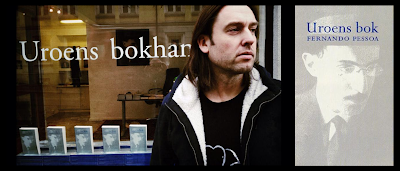Em 2014, o norueguês Christian
Kjelstrup abriu em Oslo a “Livraria do Desassossego” por uma semana, onde
vendeu exclusivamente o “Livro do Desassossego”, de Fernando Pessoa. Em norueguês,
Uroens bok. Até os Príncipes herdeiros
foram comprar um exemplar. Fui um sucesso – 1600 cópias numa semana! A livraria
pop-up foi apoiada pela Embaixada
Portuguesa em Oslo e, para dar um ambiente mais português à livraria, o
norueguês contou com a ajuda do emigrante português Joel Oliveira, que tocou
guitarra portuguesa para os visitantes.
Christian Kjelstrup admira
Fernando Pessoa, e tem o Livro do Desassossego como a melhor obra literária do
mundo. Orgulho!
Fernando Pessoa (1888-1935) foi
um escritor português que escreveu seu trabalho sob vários heterónimos, sendo
os mais importantes Alberto Caeiro, Álvaro de Campos e Ricardo Reis. O "Livro
do Desassossego" foi escrito sob o pseudónimo Bernardo Soares e publicado
postumamente, em 1982. Foi destaque no Top 100 Obras em Literatura Mundial.
Nesse ano, o norueguês levou
ainda a livraria até ao Chiado, em Lisboa, e mais tarde… a uma ilha norueguesa no
Ártico, Svalbard.
Obrigada, Christian Kjelstrup!
- - - - -
In 2014, the Norwegian Christian
Kjelstrup opened the “Bookstore of Disquiet” in Oslo, for one week, to sell Fernando
Pessoa’s “The Book of Disquiet” exclusively. In Norwegian, Uroens bok. Even the Crown Princes went there to buy a copy. I was
a success - 1600 copies in one week! The pop-up bookstore was supported by the
Portuguese Embassy in Oslo, and in order to get a Portuguese atmosphere, the
Norwegian had the help of the Portuguese emigrant Joel Oliveira, who played
Portuguese guitar for the visitors.
Christian Kjelstrup admires
Fernando Pessoa, and has “The Book of Disquiet” as the best literary work in
the world. Proud of that!
Pessoa (1888-1935) was a a
Portuguese writer who penned his work under several heteronyms, the most
important of them being Alberto Caeiro, Álvaro de Campos and Ricardo Reis.
"The Book of Disquiet" was actually written under the pseudonym
Bernardo Soares and published posthumously, in 1982. It was featured in the Top
100 Works in World Literature.
In the same year, the Norwegian
took the bookstore to Chiado, in Lisboa, and later… to a Norwegian island in
the Artic, Svalbard.
Thank you, Christian
Kjelstrup!






